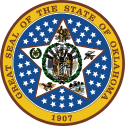- Oklahoma Chief Medical Examiner
-
Office of the Chief Medical Examiner 
Great Seal of Oklahoma Agency overview Formed January 2, 1962 Headquarters 901 N. Stonewall
Oklahoma City, OklahomaEmployees 72 classified
6 unclassifiedAnnual budget $7 million Ministers responsible Kevin Ward, Secretary of Safety and Security
Ted W. Violett, M.D., Chairman of the BoardAgency executives Dr. Andrew Sibley, Interim Chief Medical Examiner
Vacant, Deputy Chief Medical ExaminerParent agency Board of Medicolegal Invesitgations Website Office of the Chief Medical Examiner The Oklahoma Chief Medical Examiner is the Oklahoma state official responsible for investigating sudden, unexpected, violent or suspicious deaths and determining the cause of death. The Chief Medical Examiner provides toxicological and pathological services to aid in the investigation of any death subject to public inquiry. The Chief Medical Examiner heads the Office of the Chief Medical Examiner (OCME), which is a state agency.
The current Interim Chief Medical Examiner is Dr. Andrew Sibley, who was appointed by the Board on June 5, 2010, amid a growing controversry and political corruption investigation.
Contents
Overview
The Chief Medical Examiner was created by the Oklahoma Legislature in 1961 but did not receive funding until 1967. The Office of the Chief Medical Examiner is governed by the Board of Medicolegal Investigations. The Chief Medical Examiner must be a licensed physician, trained and certified in forensic pathology.
Leadership
The Office of the Chief Medical Examiner is under the supervision of the Secretary of Safety and Security. Under Governor of Oklahoma Brad Henry, Kevin Ward is currently serving as the Secretary.
Board of Medicolegal Investigations
The Board of Medicolegal Investigations is the governing is policy-making body for the Chief Medical Examiner. With the exception of one member, all members of the Board are ex officio members or that members designee. The Board elects one of its members to serve as chair and one of its members as vice-chair. Members of the Board receive no compensation for their services on this Board.
- The Director of the State Bureau of Investigation
- The State Commissioner of Health
- The Dean of the College of Medicine of the University of Oklahoma
- The President or Dean of the Oklahoma State University - Center for Health Sciences
- The President of the Oklahoma Bar Association - J. William Conger (Bill Conger)
- The President of the Oklahoma Osteopathic Association
- The President of the Oklahoma State Medical Association
- A funeral director appointed by the Oklahoma State Board of Embalmers and Funeral Directors
The current Board members are:
- Ted W. Violett, M.D. (Chairman)
- Tom Jordan
- Nancy Hall, Ph.D.
- Jim Cooper, Vice-Chairman
- Michael Crutcher, M.D.
- John Fernandes, D.O.
- Shanda McKenney
Administration
The Board appoints the Chief Medical Examiner, who serves at the Board's pleasure. The Chief Medical Examiner is the chief executive of OCME and is responsible for the overall performance of its duties. The Chief Medical Examiner also serves be an ex officio nonvoting member of the Board.
Controversy
The Office of the Chief Medical Examiner is central part of the 2010 Oklahoma political corruption investigation.
Organization
- Board of Medicolegal Investigations
- Chief Medical Examiner
- Deputy Chief Medical Examiner
- Administration Division
- Central Investigation Division
- Eastern Investigation Division
- District Offices
- Deputy Chief Medical Examiner
- Chief Medical Examiner
Powers and Duties
Oklahoma law requires that all human deaths of the types listed below must be reported to the Chief Medical Examiner and investigated by him.
- Violent deaths, whether apparently homicidal, suicidal or accidental including but not limited to deaths due to thermal, chemical, electrical or radiational injury and deaths due to criminal abortions, whether self-induced or not.
- Deaths under suspicious, unusual or unnatural means.
- Deaths related to disease which might constitute a threat to public health.
- Deaths unattended by a licensed medical or osteopathic physician for fatal or potentially fatal illness.
- Deaths of persons after unexplained coma.
- Deaths that are medically unexpected and that occur during a therapeutic procedure.
- Deaths of any inmate occurring in any place of penal incarceration.
- Deaths of persons whose bodies are to be cremated, buried at sea, transported out of state or otherwise made ultimately unavailable for pathological study.
References
See also
Categories:- State law enforcement agencies of Oklahoma
- Medical examiners
Wikimedia Foundation. 2010.

